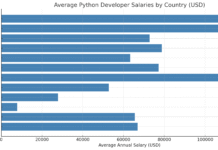Key Takeaways
- BIM software adoption is accelerating globally, driven by government mandates, digital transformation, and sustainability goals in the AEC sector.
- Integration with AI, cloud computing, and digital twins is enhancing collaboration, accuracy, and lifecycle management across construction projects.
- The 2025 data highlights a growing trend toward smart, data-driven construction practices that improve efficiency, reduce costs, and minimize waste.
In the rapidly evolving world of architecture, engineering, and construction (AEC), Building Information Modeling (BIM) software has emerged as a cornerstone of digital transformation.
As the global construction industry accelerates its adoption of advanced technologies, BIM is playing a critical role in reshaping how infrastructure projects are designed, built, and managed.
By integrating 3D modeling with real-time data and collaborative workflows, BIM software enables stakeholders to enhance efficiency, reduce waste, lower costs, and improve project outcomes across the lifecycle of a building or infrastructure.

As we step into 2025, the influence of BIM software continues to expand, fueled by emerging technologies such as cloud computing, artificial intelligence (AI), machine learning, digital twins, and augmented reality (AR).
These innovations are not only enhancing the capabilities of BIM tools but are also driving significant shifts in global construction practices, regulations, and market expectations.
Consequently, businesses, governments, and professionals across the AEC sector are increasingly relying on BIM platforms to meet their strategic goals—ranging from sustainable construction and smart city development to cost-effective project delivery and regulatory compliance.
The growing demand for infrastructure modernization, urban expansion, and sustainable building practices is also contributing to the global surge in BIM adoption.
Countries around the world are mandating BIM for public infrastructure projects, and private developers are investing heavily in BIM-enabled solutions to gain a competitive edge.
Moreover, the integration of BIM with cloud-based collaboration tools and mobile applications has made it more accessible to small and mid-sized firms, broadening its adoption across different project scales and geographies.
Understanding the latest BIM software statistics, usage data, and trends in 2025 is essential for AEC professionals, technology providers, construction firms, policymakers, and stakeholders who wish to stay competitive in this dynamic industry.
From market size and regional growth projections to adoption rates, user demographics, and technological innovations, the data offers deep insights into how BIM is transforming the construction landscape.
This comprehensive blog brings together the top 50 latest BIM software statistics, data points, and key trends for 2025, offering a detailed and data-driven perspective on the current and future state of BIM technology.
Whether you’re evaluating software investments, analyzing industry benchmarks, or exploring emerging opportunities, the following insights will serve as a valuable resource to help you make informed decisions in a digital-first construction era.
Before we venture further into this article, we would like to share who we are and what we do.
About 9cv9
9cv9 is a business tech startup based in Singapore and Asia, with a strong presence all over the world.
With over nine years of startup and business experience, and being highly involved in connecting with thousands of companies and startups, the 9cv9 team has listed some important learning points in this overview of the Top 50 Latest BIM Software Statistics, Data & Trends.
If your company needs recruitment and headhunting services to hire top-quality employees, you can use 9cv9 headhunting and recruitment services to hire top talents and candidates. Find out more here, or send over an email to [email protected].
Or just post 1 free job posting here at 9cv9 Hiring Portal in under 10 minutes.
Top 50 Latest BIM Software Statistics, Data & Trends
- The global market for building design and Building Information Modeling (BIM) software was valued at approximately $3.54 billion in 2025, and it is forecasted to nearly double, reaching an estimated $7.21 billion by the year 2033, reflecting a compound annual growth rate (CAGR) of 7.6% over this period.
- According to recent market analyses, the overall value of the global BIM market was €3.78 billion in 2020, and it is expected to grow significantly to €7.39 billion by 2025, representing a robust year-on-year growth rate of 14.5%, driven by increasing adoption across various construction sectors.
- Projections indicate that the Building Information Modeling market size will expand from USD 9.93 billion in 2025 to USD 19.04 billion by 2030, exhibiting a strong compound annual growth rate of approximately 13.9%, fueled by technological advancements and increasing demand for digital construction workflows.
- The current valuation of the BIM software market stands at around $5.40 billion, with forecasts suggesting it will grow at a rapid CAGR of 22.79% in the coming years, as more construction firms integrate BIM solutions to streamline project management and collaboration.
- In 2022, the Building Information Modeling market was valued at USD 6.08 billion, and it is projected to more than double to USD 17.69 billion by 2030, growing at a CAGR of 12.6%, driven by rising infrastructure investments and government mandates encouraging BIM adoption.
- Industry estimates place the size of the Building Information Modeling sector at approximately USD 10.12 billion in 2025, highlighting the increasing reliance on BIM technologies for efficient building design and construction management.
- Market forecasts predict that the global BIM market will grow from USD 9.11 billion in 2025 to an impressive USD 49.49 billion by 2037, maintaining a CAGR exceeding 13.8%, as digital transformation continues to reshape the architecture, engineering, and construction (AEC) industries.
- The Architectural BIM Software segment alone is expected to witness substantial growth, with its market size projected to increase from USD 9.34 billion in 2025 to USD 33.64 billion by 2033, reflecting a compound annual growth rate of 17.37%, as architects increasingly adopt BIM for design accuracy and collaboration.
- The building information modeling market is anticipated to grow from $7.39 billion in 2024 to $8.59 billion in 2025, registering a compound annual growth rate of 16.3%, driven by expanding construction activities and the integration of BIM with emerging technologies.
- By 2029, the global building information modeling market size is expected to reach $16.43 billion, growing at a CAGR of 17.6%, as BIM solutions become standard practice in managing complex construction projects and improving operational efficiency.
- In 2025, North America is projected to hold the largest share of the BIM market globally, owing to widespread adoption of BIM technologies across commercial and public infrastructure projects, supported by strong government policies and industry standards.
- The Asia Pacific region is forecasted to exhibit the highest compound annual growth rate in the BIM market between 2025 and 2030, driven by rapid urbanization, infrastructure development, and increasing investments in smart city projects in countries such as China, India, and Japan.
- Europe and North America collectively dominate the BIM software market, accounting for approximately 35% and 30% of the total market share respectively, due to early adoption, regulatory mandates, and advanced technological infrastructure.
- Global BIM adoption rates are on a steady rise in 2025, with commercial construction sectors leading the way, while residential construction projects are increasingly integrating BIM tools to improve design precision and reduce construction errors.
- Government mandates such as the UK’s BIM Level 2 requirement, which has been compulsory for public sector projects since 2016, continue to drive BIM adoption, ensuring higher standards of project collaboration and data management in infrastructure development.
- The integration of BIM with artificial intelligence (AI) and machine learning technologies is enhancing automated design optimization and decision-making processes, enabling stakeholders to predict project outcomes more accurately and reduce costly errors.
- The BIM software market is currently experiencing a compound annual growth rate of 22.79%, propelled by the growing need to streamline workflows, improve collaboration among project teams, and reduce overall construction costs through digital tools.
- Growth in the BIM market is strongly supported by government initiatives worldwide that either mandate or incentivize the use of BIM in public construction projects, thereby accelerating adoption and standardization across the industry.
- Increasing project complexity, coupled with the rising demand for sustainable and energy-efficient building practices, significantly fuels the growth of the BIM market, as these technologies enable better visualization and management of building performance.
- Technological advancements such as cloud-based BIM solutions, augmented reality (AR), and virtual reality (VR) integration are key drivers behind the expansion of the BIM software market, offering enhanced accessibility and immersive design experiences.
- BIM’s capability to provide real-time insights into project progress, resource allocation, and cost management is a critical factor driving its adoption, as it allows stakeholders to make informed decisions and mitigate risks throughout the construction lifecycle.
- Various industry reports estimate the global BIM market’s compound annual growth rate to range between 7.6% and 22.79%, depending on the specific market segment and geographic region, reflecting the dynamic nature of BIM adoption worldwide.
- The estimated market size for BIM in 2024 was approximately USD 8.55 billion, underscoring the rapid growth and increasing importance of BIM technologies in the building design and construction sectors.
- The building design and BIM software market encompasses multiple types of BIM, including 3D modeling, 4D scheduling, and 5D cost estimation, each contributing to more integrated and efficient construction project management.
- BIM adoption in residential construction is on the rise, particularly for multi-family housing and luxury home projects, where precise design coordination and cost control are essential for project success.
- The growth of the BIM market is closely linked to rising urbanization and infrastructure development in Asia-Pacific countries such as China, India, and Japan, where governments are investing heavily in modernizing construction practices.
- One of the primary benefits driving BIM adoption is its ability to reduce overall project costs and timelines by improving collaboration among stakeholders and minimizing errors through accurate digital modeling.
- The BIM software market is segmented by deployment type, with on-premises solutions currently prevalent, while cloud-based BIM deployments are gaining traction due to their scalability and remote accessibility.
- BIM technologies are increasingly utilized across all phases of construction projects, including preconstruction planning, active construction management, and facility operation and maintenance.
- Key subsegments within the BIM software market include 3D modeling software, BIM management platforms, and visualization tools, each serving distinct but complementary roles in the building design process.
- BIM-related services such as consulting, implementation, training, and technical support are growing rapidly, reflecting the increasing complexity and customization required by organizations adopting BIM technologies.
- The expansion of building lifecycle management practices and the establishment of industry standards are significant factors supporting the sustained growth of the BIM market globally.
- The acceleration of BIM adoption is largely driven by the need to efficiently manage increasingly complex construction projects, where collaboration and data integration are essential to project success.
- The United States is experiencing significant BIM market growth due to widespread technology adoption across both private and public sectors, bolstered by government support and industry initiatives.
- Integration of BIM with digital twin technologies and AI is enhancing sustainability and operational efficiency in smart city projects, allowing real-time monitoring and predictive maintenance of urban infrastructure.
- Investments in large-scale infrastructure projects such as smart cities, green buildings, and advanced transportation networks are key drivers propelling the growth of the BIM market worldwide.
- Behavioral factors, including the skill level of designers and changes in design intentions, have a significant impact on BIM design quality, with predictive modeling studies reporting an R-squared value of 0.88, indicating strong correlation.
- Despite its growth, BIM adoption faces challenges that vary depending on project scale and scope, including technological barriers, organizational resistance, and the need for skilled personnel.
- BIM adoption rates tend to be higher in commercial construction projects compared to residential ones, although residential BIM adoption is steadily increasing as the benefits become more widely recognized.
- Environmental concerns and the need to reduce construction waste and carbon emissions are driving demand for BIM, as it enables more precise planning and resource management to minimize environmental impact.
- BIM facilitates more accurate modeling and simulation of building performance, which helps architects and engineers design structures that are more energy-efficient and environmentally sustainable.
- The rise of cloud-based BIM solutions is a major factor supporting market growth, offering enhanced collaboration capabilities and enabling real-time data sharing among geographically dispersed project teams.
- The expansion of virtual reality (VR) and augmented reality (AR) technologies in the construction industry is further accelerating BIM software market growth by providing immersive design visualization and improved stakeholder engagement.
- Increasing emphasis on data-driven decision-making in construction projects is driving the adoption of BIM software, as it provides comprehensive data integration and analytics capabilities.
- Estimates for the BIM market’s compound annual growth rate between 2025 and 2030 vary from 12.6% to 17.6%, depending on the source and specific market segments analyzed.
- The rising complexity of construction projects and the growing demand for collaborative workflows are key factors driving the growth of the BIM software market globally.
- Government mandates and certification requirements worldwide play a crucial role in influencing BIM adoption rates, as regulatory frameworks increasingly require or encourage BIM use in construction projects.
- The proliferation of remote collaboration tools and digital communication platforms is supporting BIM market expansion by facilitating seamless teamwork among distributed project stakeholders.
- The growing focus on building performance analysis and integration with facility management systems is driving demand for BIM solutions that extend beyond design and construction into the operation phase.
- Technological innovations such as artificial intelligence (AI), machine learning (ML), virtual reality (VR), augmented reality (AR), and cloud computing are collectively fueling the expansion of the BIM market by enhancing software capabilities and user experience.
Conclusion
As the global construction and infrastructure sectors undergo unprecedented digital transformation, the insights derived from the top 50 latest BIM software statistics, data, and trends in 2025 underscore the central role of Building Information Modeling in shaping the future of the Architecture, Engineering, and Construction (AEC) industry. From driving efficiencies in project delivery to fostering real-time collaboration and supporting sustainability initiatives, BIM software continues to revolutionize how buildings and infrastructure are planned, designed, constructed, and maintained.
The data and trends analyzed throughout this blog reveal that BIM adoption is no longer a niche practice reserved for large-scale projects or elite firms. Instead, it is a critical enabler of digital construction embraced by small and medium-sized enterprises (SMEs), large multinational corporations, and public sector agencies across the globe. With national governments increasingly implementing BIM mandates and industry standards evolving to support integrated project delivery models, BIM is rapidly becoming a non-negotiable requirement rather than a competitive advantage.
Moreover, the integration of BIM with disruptive technologies—such as Artificial Intelligence (AI), Internet of Things (IoT), digital twins, and cloud-based platforms—is accelerating its potential to deliver smarter, safer, and more cost-effective outcomes. These innovations are enabling AEC professionals to enhance project accuracy, mitigate risks, and simulate real-world performance long before physical construction begins. The availability of detailed, real-time data through BIM platforms also supports more informed decision-making, improved asset lifecycle management, and enhanced stakeholder engagement.
Another key takeaway from the 2025 statistics is the growing emphasis on sustainability and green building design, with BIM playing an instrumental role in modeling energy-efficient systems, reducing material waste, and achieving compliance with global environmental standards. As the construction industry works toward net-zero targets and climate-resilient infrastructure, BIM is emerging as a foundational technology to meet these pressing demands.
From global market expansion and sector-specific adoption rates to software feature trends and future projections, the compilation of these 50 data points serves as a critical resource for professionals aiming to stay competitive in a rapidly changing landscape. Whether you are a construction manager seeking to optimize workflows, an architect pursuing precision in design, or a policymaker shaping digital transformation initiatives, understanding these insights is essential for strategic planning and innovation.
In conclusion, the evolution of BIM software in 2025 reflects a broader shift toward digital integration, sustainability, and collaborative project delivery in the built environment. The continued growth in BIM usage and investment signals a future where intelligent data modeling is not just an optional enhancement—but a fundamental necessity. By leveraging the latest trends and statistics, stakeholders across the construction ecosystem can position themselves to thrive in an increasingly data-driven and technology-enabled world. As BIM continues to mature and evolve, staying informed about its developments will be critical to unlocking its full potential in the years ahead.
If you find this article useful, why not share it with your hiring manager and C-level suite friends and also leave a nice comment below?
We, at the 9cv9 Research Team, strive to bring the latest and most meaningful data, guides, and statistics to your doorstep.
To get access to top-quality guides, click over to 9cv9 Blog.
People Also Ask
What is Building Information Modeling (BIM)?
Building Information Modeling (BIM) is a digital process that integrates 3D models and data to improve planning, design, construction, and facility management.
Why is BIM important in 2025?
In 2025, BIM is crucial for enhancing project efficiency, collaboration, cost reduction, sustainability, and meeting regulatory requirements in construction.
What are the latest BIM software trends in 2025?
Key trends include AI integration, cloud collaboration, digital twins, mobile access, sustainability modeling, and government BIM mandates.
How widely is BIM software adopted in 2025?
BIM adoption is growing globally, with over 70% of construction firms using BIM tools, driven by digital transformation and policy requirements.
Which industries are using BIM software the most in 2025?
AEC industries—architecture, engineering, and construction—are the primary users, with growing use in infrastructure, real estate, and facility management.
What is the global BIM software market size in 2025?
The global BIM software market is projected to exceed $15 billion in 2025 due to increased demand for digital construction solutions.
Which countries are leading BIM adoption in 2025?
Countries like the UK, USA, Germany, China, and Singapore are leading BIM adoption, especially for public infrastructure projects.
How is AI impacting BIM software in 2025?
AI enhances BIM by enabling predictive analytics, automated clash detection, intelligent scheduling, and better design optimization.
What role does cloud computing play in BIM in 2025?
Cloud-based BIM platforms facilitate real-time collaboration, data sharing, and remote project access across teams and stakeholders.
What is a digital twin in relation to BIM?
A digital twin is a dynamic digital representation of a physical asset, created and managed using BIM data and real-time sensor inputs.
Is BIM software helping with sustainability in 2025?
Yes, BIM enables energy modeling, material optimization, and lifecycle analysis to support sustainable and green building initiatives.
Are governments mandating BIM use in 2025?
Many governments, including in the UK, EU, and parts of Asia, require BIM for public projects to improve transparency and efficiency.
What are the top BIM software tools in 2025?
Popular BIM tools in 2025 include Autodesk Revit, Archicad, Bentley Systems, Vectorworks, Navisworks, and Trimble Connect.
How does BIM improve construction project outcomes?
BIM improves outcomes through better visualization, clash detection, cost estimation, scheduling, and integrated project delivery.
What are the main benefits of using BIM in 2025?
BIM enhances productivity, reduces rework, improves coordination, supports sustainability, and lowers project costs and delays.
How is BIM used in infrastructure projects in 2025?
BIM is used to plan, design, and manage transportation, utilities, and public infrastructure with greater efficiency and accuracy.
Can small construction firms use BIM in 2025?
Yes, affordable cloud-based BIM solutions make it accessible for small and medium-sized firms to streamline their operations.
How has BIM software evolved in recent years?
BIM software has evolved to include AI features, cloud platforms, mobile integration, and support for smart building technologies.
What is the future of BIM software beyond 2025?
Future trends include increased use of generative design, IoT integration, 6D BIM for sustainability, and VR for immersive modeling.
Is BIM software compatible with mobile devices in 2025?
Many BIM platforms offer mobile access, allowing field teams to view and update models in real time from construction sites.
What are 6D and 7D BIM dimensions?
6D BIM focuses on sustainability and energy performance, while 7D BIM involves facility management and long-term operational insights.
Are BIM and CAD the same?
No, CAD is for drafting and design, while BIM is a comprehensive data-rich model that includes scheduling, cost, and performance info.
How does BIM reduce construction costs?
By improving design accuracy, reducing rework, identifying clashes early, and enabling better planning, BIM significantly cuts costs.
What challenges does BIM face in 2025?
Challenges include high initial costs, lack of skilled professionals, software interoperability, and resistance to digital change.
What is the ROI of BIM software in 2025?
Firms report a high ROI through reduced project delays, lower error rates, improved productivity, and better resource management.
What are BIM Level 2 and Level 3 standards?
Level 2 BIM uses collaborative 3D models with separate data environments; Level 3 involves full integration in a common data environment.
Is BIM used in renovation and retrofit projects?
Yes, BIM helps assess existing structures, optimize renovation plans, and manage retrofits with improved efficiency and accuracy.
What certifications are available for BIM professionals?
Popular certifications include Autodesk Certified Professional, buildingSMART certification, and RICS BIM Management accreditation.
How does BIM improve collaboration among stakeholders?
BIM allows real-time sharing of models and updates, improving coordination and reducing miscommunication between project teams.
What is the impact of BIM on project timelines?
BIM significantly shortens project timelines by streamlining workflows, preventing errors, and enabling faster decision-making.
Sources:
– Archive Market Research Report (2024-05-20)
– 3D Design Bureau (2025 forecast)
– Mordor Intelligence (2024-09-20)
– Market Report Analytics (2025-02-27)
– Linjiarui.net (2025-01-22)
– Verified Market Research (2024-06-27)
– LinkedIn Article on BIM Future (2025-01-20)
– Research Nester (2025-01-28)
– Global Growth Insights (2024-10-30)
– The Business Research Company (2022-12-01)































![Writing A Good CV [6 Tips To Improve Your CV] 6 Tips To Improve Your CV](https://blog.9cv9.com/wp-content/uploads/2020/06/2020-06-02-2-100x70.png)


